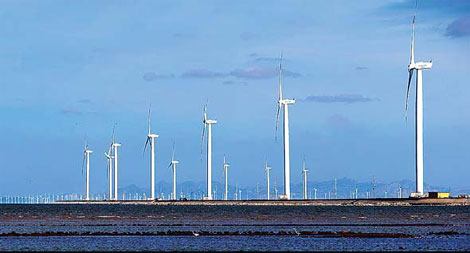Shandong sees opportunities in marine economy's future
 0 Comment(s)
0 Comment(s) Print
Print E-mail
China Daily, November 7, 2011
E-mail
China Daily, November 7, 2011
 |
| Shandong wind farm, a vital part, and "good start", for the province's marine economy. Photos provided to China Daily |
China's Shandong Peninsula, which is just across the Yellow Sea from South Korea and Japan, has seen rapid growth in marine-related industries since its marine economic zone became a part of the nation's development strategy, this past January.
"We've already made a good start in developing the peninsula's marine economy zone," Jiang Yikang, Shandong's Party secretary, commented.
In the first half of the year, the zone's output was worth 1.04 trillion yuan ($164 billion), an increase of 11.7 percent year-on-year, Jiang said.
The remarks came at the 2011 China International Blue Economy Summit, on October 28, in Qingdao, another Shandong coastal city.
The forum drew several hundred marine experts and officials from 18 countries to discuss the future of China's marine economy.
Shandong peninsula is at a key juncture of the rim of the Bohai Sea and the Northeast Asia Economic Circle, and has a more-than 3,000-kilometer coastline, a sixth of the nation's total, and more than 200 harbors.
Its economic zone is the first regional zone of its kind to get State Council (China's cabinet) backing. It covers 64,000 square kilometers of land with six cities - Qingdao, Dongying, Yantai, Weifang, Weihai and Rizhao.
The provincial government has a number of ambitious development plans and has pledged to spend 1.4 trillion yuan, by 2020, on modernizing its marine industries.
These include marine organisms, equipment manufacturing, mineral and resource exploration, fishing, transportation, tourism, engineering, and environmental protection.
In this, it is giving priority to developing industrial areas, such as the Longkou marine-equipment manufacturing district, the Binzhou Marine Chemicals district, the Dongjiakou Marine Hi-tech Industry district, and the Dongying Petroleum Industry cluster.
To indicate its growing importance, Song Junji, deputy director of construction for the marine economic zone, explained, "The zone's now become a hot investment destination."
Song said that it had 528.4 billion yuan in fixed assets in the first half of this year, up by 22.9 percent year-on-year, and accounting for nearly half the province's total.
At a promotional conference in Beijing in February, it secured 23 projects, worth more than 254.9 billion yuan.
"The zone has helped provincial development overall and it is on the way to becoming a national marine-manufacturing industry center, a high-tech marine research and development center, and a shipping center for northeast Asia," said the provincial governor, Jiang Daming.
The provincial government is trying to help 10 marine equipment manufacturers, each with an annual production value of over 10 billion yuan, and 30 companies in emerging marine industries, each with an annual production value of 1 billion yuan.
It also has around 150 major projects and 40 marine industrial parks under construction.
One of these involves building an artificial archipelago off Longkou Bay, in Yantai. The island chain will have a total land surface of at least 35 sq km.
The project is expected to cost 20 billion yuan and to be finished by 2014. It is also expected to have an annual output value of 300 billion yuan, and provide jobs for 100,000 skilled workers by 2020.
Shandong's scientific research advantages were described by Li Naisheng, the deputy director of Shandong's science and technology department, who explained, "Technological innovation is vital to the marine economy zone's development and Shandong will cooperate with institutions and universities all over the world to develop it."
The province already has at least 40 percent of China's marine scientists, more than a third of its ocean research institutes, and half of its oceanic scientific research programs. All of these are in Qingdao, which has the vision of becoming China's "Blue Silicon Valley" - that is to say, an international center for marine science and technology and technological innovation.
By 2015, Shandong plans to have eight more model marine scientific and technological bases and 10 alliances for strategic industrial innovation to provide technological support for the zone.
"Shandong's Blue Economic Zone is set to become an international leader in modern marine industry and the center of international marine science and technological development, in five to 10 years.
"Its experience can be used by other coastal provinces," concluded Du Ying, a vice-minister with the National Development and Reform Commission.





